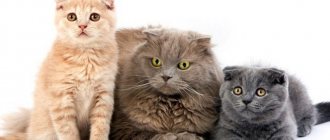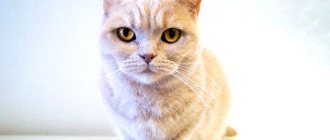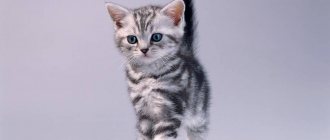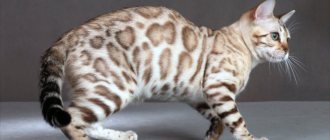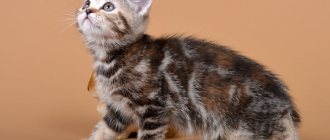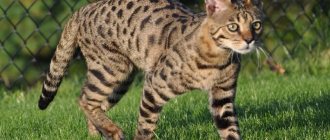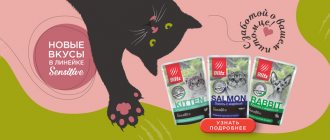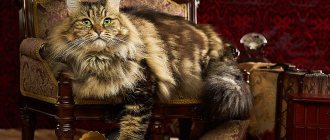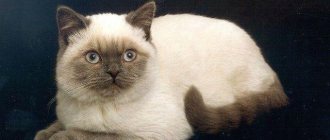It all starts at the embryonic stage of development. First, pigment cells appear, which are not yet able to produce color. They migrate to the hair follicles, take the form of an elongated capsule and are distributed along the length of the hair. The variety of colors in cats is the merit of only two melanins - red and black.
British cats of peach (cream) color belong to the group of red cats, in which parents passed on the genetic pheomelanin inheritance to their offspring. Let's find out how the coat color of cats is formed and whether there are differences in the character of animals with peach color.
Characteristics of British kittens
Breeders select healthy individuals without genetic or other abnormalities, with a stable psyche and a friendly attitude towards people.
By purchasing an animal without documents, you risk purchasing a pet with diseases of various origins, weak immunity, or encountering unpredictable behavior. Because a breed is not only a name and appearance, but also a character.
British cats need constant attention, which is important for people who are outside the house all day. With a self-sufficient and independent character, British cats are not aggressive in critical situations and are not prone to attacking people.
From birth, the British are clean and almost immediately get used to the tray and scratching post.
As for the appearance of the British, they are easily recognizable among others. British cats are classic representatives of the semi-cobby type. This body type includes the following characteristics:
- strong and short wide-boned body;
- short rounded paws:
- powerful short neck;
- a large round head with cheeks that resemble jowls;
- erect ears with soft rounded tips;
- Their nose (British cats), wide from the bridge of the nose to the tip, has a depression;
- large round eyes;
- short tail with thickening at the base and rounding at the end.
Thus, the British is a collection of soft, rounded shapes. All physical parameters are strictly regulated, so deviations from them are considered a violation of the standards and result in the cat being rejected.
But in addition to their special memorable appearance, these cats have good hereditary characteristics. With proper care, they have virtually no health problems, and their life expectancy ranges from 12 to 20 years.
It is widely believed that a British cat can be distinguished from its relatives of another species by its eye color. This is not an exact sign, since a kitten’s eye color can only be fully determined by the first year of life.
In addition, eye color is tied to coat color and this must be taken into account when choosing a pet, as well as the fact that the presence or absence of certain traits is genetic.
Genes are divided into dominant and recessive, which means that no matter how beautiful blue eyes look, they are rare among British cats. After all, the gene for blue eyes is recessive, that is, it is suppressed by others.
If you cross a British and a Scotsman
Representatives of the cat family are not particularly scrupulous from a moral point of view, and therefore they can end up with any random breed. But owners must carefully monitor their purebred murks and, above all, worry about their health.
Illiterate mating of a Briton with a Scot can lead to skeletal deformities in future kittens or “reward” them with hereditary diseases, even if mom and dad are completely healthy. Crossing a British cat with a Scottish fold cat is allowed only in a professional cattery. There, an experienced breeder who is well acquainted with the anatomy of cats and the structure of their skeletons will select a pair. In addition, the entire process will be controlled by the club's breeding commission.
Mating, pregnancy, birth of British breed cats >>
When trying to get a mix of British and Scots, you should remember that the British breed is a closed one. This means that these pets can only be brought together with their own kind. Scots are allowed to knit according to the principle of Scottish Straight + Scottish Fold. It is extremely rare that Scottish cats are crossed with British cats, only if there is a need to breed some color or improve the bone structure. At the same time, the WCF system has prohibited any interbreed crosses since 2004.
However, when these animals are mated, the result is a rather cute Scottish or British fold.
Differences in coat quality and color
There are two types of British cats: British Shorthair and British Longhair.
The classic color is blue (gray). Moreover, the color of the coat and undercoat must match.
Because of this feature, British cats are often confused with Russian blue cats. However, after carefully studying the standards of both breeds, it becomes clear that these are different animals.
Meanwhile, breeders are working to create new color options for cats without losing other standards of the species. Today there are already white, red and black colors, as well as many shades, for example, British reds are divided into red (bright red) and cream (peach).
Other peach-colored breeds
At first glance, it may seem that the colors of cats are evenly distributed across groups and are not subject to any regulation. In practice, everything looks completely different. Each population has “signature” colors that are familiar to a given breed.
For the British it will be gray-blue, for Angoras it will be traditional white, Persians are almost always red, and Turkish Vans generally became the founders of a unique combination of white and red shades.
Peach wool did not become a distinctive feature of any of the breeds, although as a derivative of the red color it spread very widely.
Cats of the following breeds can have peach color in various shades:
- Anatolian and Brazilian cats;
- German rex and giant aphrodite;
- Karelian and Kurilian bobtails;
- large Maine Coons and Norwegian Forest cats;
- Laperms, Lamkins, Mandalays and Munchkins;
- Siberian, Persian and Turkish Angoras.
In total, about fifty breeds, besides the British, can wear a wonderful peach coat, and the list only increases from year to year.
This is interesting! Even hairless cats (Canadian and Don Sphynxes) can be peach-colored.
At what age will the difference be clearly visible?
The characteristic appearance of the British breed distinguishes them from representatives of other breeds even at a very young age. However, only an adult, mature individual can be checked for compliance with the standards. Then we can say whether it is a purebred cat or a crossbreed.
Depending on the breed, the age at which a cat is considered an adult also varies. Bengal cats take 9 months to fully mature, Maine Coons take 2 years.
The British breed is considered mature at 12 months of age. Around this time, all processes associated with changes in coat and eye color are completed.
Popularity of ginger cats
Animals with fiery fur have been popular at all times, but now it’s a real boom. They are featured in advertisements, and cartoons are made about them that people like. For example, the same Garfield leaves neither children nor adults indifferent with his constant pranks. Or Puss in Boots from the cartoon about Shrek. His bottomless eyes and wit make millions of people and children around the world smile.
Among creative individuals there are also lovers of fiery animals. They are also painted in paintings, figurines are made, and soft toys are sewn. For example, the contemporary Russian artist Vasya Lozhkin has a whole series of works about red cats.
Is it possible to identify a Briton by his behavior?
There are also standards for the behavioral characteristics of a cat. The British are calm and clean pets, aristocrats from the cat world, so many people choose this breed due to its character.
These animals are not prone to hooliganism and find peaceful activities in the absence of their owners, for example, playing with specially designated objects or sleeping. They are easy to train to the litter tray and scratching post.
When you meet, don’t be shy about asking for documents and pedigree of the animals. Thanks to it, you will be able to understand what adult cats and cats from this litter will be like, because their external signs of kittens can change with age.
In a specialized club or nursery, future owners will be given a confirmation that the kitten belongs to their breed, a conclusion about its state of health and a certified birth certificate or a pedigree compiled on the basis of the metric, which will detail information about the ancestors up to the fourth generation. This is not cheap, nor is purchasing a purebred animal.
If it so happens that your pet is not a completely purebred representative of the breed, the swindlers can be held accountable by contacting law enforcement agencies and receive compensation in accordance with the procedure established by the court.
And the kitten you adopted is a living creature that loves you. He is already a new member of the family, a devoted friend and companion. Be responsible and merciful, do not abandon those you have tamed.
Basic moments
- This breed has been around the British for so long that in its homeland it is simply called shorthair.
- Recognizable features are a round muzzle, a stocky body and thick fur of a special texture, tactilely reminiscent of plush.
- Long before the appearance of the first “cat” organizations, the British Shorthair cat was valued not for its external qualities, but for its unsurpassed skill as a mouser.
- Animals openly show their affection for their owners, but do not like to sit on a person’s lap or hang in a person’s arms.
- They get along well with other pets (including dogs, rodents and birds), but do well as an only pet.
- Cats do not require complex and specific care.
- After reaching adulthood, the level of physical activity decreases significantly.
- Veterinarians call obesity the main danger facing British apartment dwellers.
- British Shorthairs are generally considered to be healthy cats, with an average lifespan of 12-17 years.
The British Shorthair cat is one of the breeds that nature has worked on much longer than humans. As a result, we have a physically developed, harmoniously built animal with a light, easy-going character. Living together with him will not cause the owners much trouble. British cats are attractive due to their calm disposition, bordering on phlegmaticity, good manners and incredibly beautiful, pleasant to the touch plush fur. In the famous book “Alice in Wonderland” Lewis Carroll forever immortalized this breed in the image of the Cheshire cat.
History of the origin of the breed
The first mention of cats with drooping ear tips dates back to 1796, when an English sailor, returning to his homeland, brought one of these cats from China. However, the further fate of the animal remained unknown.
The first fold-eared cat born in Europe is believed to be a white barn cat named Susie, discovered in 1961 in Scotland, on a farm in Portshire. Susie had a naturally occurring folded-ear mutation that was passed on to half of her kittens. Farmer William Ross, who lived next door, became interested in the unusual cat. After consulting with a geneticist, Ross began breeding the fold-eared breed.
Susie soon died when she was run over by a car, but her daughter Snooks inherited the mutated gene. This was the beginning of the Scottish Fold cat breed.
A few years later the breed was recognized by the government's British Fancy Cat Council. However, in 1974 it was removed from the list of registered breeds because it turned out that the genetic anomaly that determines the unusual shape of the ears deforms the entire osteo-articular system of the animals. Kittens obtained from crossing 2 individuals with folded ears became crippled at an early age due to congenital epiphyseal dysplasia of the limbs and tail.
Origin of the cat from Great Britain.
The breed was also banned by the International Cat Federation (Fédération Internationale Féline). However, breeders in Russia, the USA and other countries continued to breed the Scottish Fold, crossing it with cats of other breeds.
The second ancestor of the British Fold has a long history and English origin. This is a British Shorthair cat. The father of the breed is considered to be Harrison Wear, an enthusiast, the first person to pay attention to the strong street cats that were exterminating rat packs in the city. He cared for them, feeding them and building outdoor kennels, and in 1871 he organized and held the first exhibition of the British breed in Britain.
During the Second World War, the British Shorthair was on the verge of extinction, but the breed still managed to survive. This is now the most sought after cat in the UK. The British love and are proud of the domestic breed of “rat dogs”, which has received recognition and is registered in all international registries.
Pedigree cats from Europe were brought to the territory of the countries of the former USSR in the late 90s and soon gained popularity among breeders. In Russia, both breeds were recognized and registered.
Breeding fold-eared cats required patience and special knowledge, since all of them, regardless of the shape of their ears (straight or folded), are carriers of the abnormal gene. American and British Shorthair breeds have become acceptable options for crossing with the Scottish Fold (in addition to a cat with straight ears). Thus, thanks to selective breeding, a breed of British Fold cats appeared, not officially recognized, but with sufficient reserves of health, energy and endurance.
History of the British Shorthair cat
Over the years, it is impossible to find documentary evidence of the first appearance of cats in the British Isles. However, researchers suggest that domesticated animals were brought there by Roman conquerors. The legionnaires, of course, did not keep them as furry friends - someone needed to protect the provisions in the holds from the attacks of ship rats. True, those rodent hunters bore little resemblance to today’s round-faced and well-built individuals; their physique was closer to the graceful and long-legged Egyptian animals.
But the free feline nature took its toll - and some of the small predators brought by the invaders moved from the decks to solid ground, and there, over time, they met wild relatives who enriched the gene pool.
For centuries, short-haired purrs lived side by side with peasants, receiving a little milk and a roof over their heads for their contribution to the fight against mice. No one, of course, cared about selecting kittens based on coat color, ear shape and tail length, so the appearance of the breed was formed naturally. It must be said that the attitude towards these cute creatures was often not just indifferent, but even hostile, while dogs were considered true friends, worthy of sugar bones and a place by the fireplace.
It was only in the second half of the 19th century that the British realized that their pets had many unique and attractive characteristics that needed to be strengthened and developed. In the Victorian era, being the owner of a cat became not shameful even for a representative of high society. The popularity of mustachios was greatly promoted by the original and witty drawings of the famous English artist Louis Wain. A talented graphic artist created a whole universe in which anthropomorphic cats play golf and bridge, go on picnics, read newspapers, have Christmas parties, sledding, play music, relax on the beach... In addition, already at the dawn of the development of photography, enthusiasts of the new art realized that how beautiful furry creatures look in the frame. In a word, the ice was broken.
On July 13, 1871, the world's first professionally organized cat show was held in London with great success. Harrison Ware, with the support of the then manager of Crystal Palace, invited 170 event participants and their owners to the former World's Fair pavilion. He also developed competition regulations, a system for awarding points and determining winners in various categories. Visitors were surprised to discover that well-groomed and well-fed cats not only look charming, but also behave like real aristocrats. The next morning, the front pages of the capital's respected newspapers were adorned with portraits of the award winners, including 14-year-old blue tabby Old Lady. By the way, it was the blue color that was considered the only correct color for British shorthairs in the last century.
After the exhibition, the once unnoticed street animals gained popularity. A breed standard, amateur clubs and the first kennels appeared. However, in the last decade of the 19th century, Great Britain was overwhelmed by the pan-European fashion for Persian cats. On this wave, during the First World War, breeders introduced the British Longhair. Experts still cannot say with certainty whether a fixed spontaneous mutation took place or whether the breeders simply used “foreign” genes in breeding.
With the outbreak of World War II, the already unfavorable situation for shorthairs became truly catastrophic. Animals, like people, died en masse under German bombing, and the policy of food austerity left no chance of maintaining nurseries. In the post-war years, the few surviving British cats were actively crossed with representatives of various breeds to produce offspring: Russian Blue, Chartreux, Persian. Due to the large percentage of mixed blood, the breed was classified as a hybrid for a long time and therefore was not registered by leading regional and world felinological organizations. The American Cat Association distinguished American Shorthairs from Old World cats in 1967, listing the latter under the name "British Blue." The ACFA accepted the breed in 1970, and The Cat Fanciers' Association (CFA) recognized the breed in 1980.
The British Fold cat is an extraordinary beauty
Greetings, dear readers! Despite the fact that professional breeders claim that officially there is no such breed as the British Fold cat, backing up these statements with facts, in the international system there are 2 varieties of British cats: shorthaired and longhaired.
Only Scottish cats have fold ears.
It is not customary for breeders to cross breeds with each other, but people have the right to cross a British cat with a Scottish cat and get a British Fold.
Nicknames for British fold cats
When choosing names for fluffy British kittens, consider several generally accepted rules:
- Any nickname must contain at least one hissing sound. With its help, a young kitten will easily remember its nickname and will be able to quickly respond to it.
- Try to come up with a name that ends with a vowel sound. It is best if it is the letter “i” or “a”.
- The cat's name should be as short as possible. 1-2 syllables are considered the best option.
Since lop-eared Britons are distinguished by unusual ears and generally funny doll-like faces, we suggest that when choosing a name, you should focus on external data.
For example, a British fold cat can proudly bear the English aristocratic name Henry, Henry, Donald, Alf, Stephen, William or Andrew. You can also choose a cool name for the boy, for example, Ushik or Ushastik. The names from children's cartoons, where the characters had funny ears, such as Mickey, Cheburakha, Elf, Shrek, Dumbo, Goofy sound interesting.
How to name a British and Scottish kitten >> How to name a kitten based on the length of its fur >>
A fold-eared girl can be called Sadness, Ushka or Fold. British cats have good royal and royal names, such as Emma, Matilda, Elizabeth. For girls with blue coat color, the names Dymka, Smokey, Sade or Malvina are perfect.
What colors can a British Fold cat have?
If you look closely at the photos of these pets, you can conclude that blue is the most popular color among them. You can also find red, chocolate, grey, black, brown and even lilac Britons. A white or peach-colored British cat is quite rare to find.
Next is a photo of a brown British cat, which shows that the pet’s fur is quite smooth and short, resembling velvet in appearance.
British breed colors
In addition to all its numerous and undeniable advantages, the British cat breed is famous for its bright and generous palette of colors - almost their entire line is presented in the breed standard. Only the most popular and well-known colors among the British have up to six dozen! And if you count new, rare colors and variations, the total number will be up to two hundred.
Different colors may be present in one litter
But even this seemingly democratic approach to the variegated ribbon of colors is clearly regulated by the breed standard in each specific case. In the exhibition evaluation of an animal, there is a very large quota of expert evaluation specifically for color - according to the standards of various international felinological organizations, this ranges from 15 to 25 points.
British cats of all stripes - photo gallery
Blue (gray)
The blue color can be called classic for the British cat breed. Against the background of plush gray fur, huge eyes of all shades of amber look especially impressive.
Description of the character of British Fold cats
Many people, before letting a pet into their home and family, try to learn as much as possible about the description of the breed and the character of the future household member. This is a very wise decision, since many cat breeds are characterized by excessive independence, lack of attachment to their owners, and are not affectionate or friendly.
All of the above has nothing to do with British kittens; they are very affectionate and friendly, they love to be stroked and “squeezed”. The British are ideal for those families with small children, they get along well with them, take part in their games with pleasure, and do not offend them, provided that they are treated the same way.
Little kittens are easy to train, they grow quickly and learn from their mother cat how to groom themselves and go to the litter box. Even those kids who grow up without a mother quickly get used to doing their chores where they should be, without burdening their owners with cleaning up after them.
But, like most cats, the British are also characterized by pride and stubbornness; if the pet does not want to sit on your lap at the moment, you cannot restrain it. These pets rarely meow, hinting to their owners that they should be fed; they would rather sit near an empty cup, pretending that their owner is very irresponsible.
The nature of these pets is such that if you love them and show them due respect, they will repay their owners in kind. Check them out in this video:
Cats with beautiful colors
Since this “picture” on cat fur is so common, there are many breeds on Earth that have patterned colors. Little “fluffy mysteries” with a similar color actively participate in numerous exhibitions and competitions held in our country. However, in order to achieve this right and worthily represent one or another organization of felinologists, a tabby cat must fully comply with the requirements and criteria for coloring, coat characteristics (for example, British Shorthair) and other criteria that are unique to each breed.
British
Representatives of the British breed are very popular. And the reason for this is precisely the unusual color. Since the British cat was created through successful experiments in crossing and selection, their result was an extremely beautiful patterned coloring of the cat's fur.
British silver tabby kittens look especially touching. However, it is difficult to find two completely identical members of the breed - the coloring of each cat is unique.
Attention! Typically, the British have symmetrical spots characterized by fairly clear lines with contrasting patterns. In general, this coloring of British tabbies is characterized by exceptional brightness and contrast.
Felinologists distinguish a number of types of the British breed. Here there are mackerel colors, spotted (leopard), classic (marbled) and even ticked. For example, the more common brindle color of cats (mackerel) is distinguished by its unusually correct pattern. As expected, there is a “scarab mark” on the British woman’s face. The eyes of such specimens are a rare copper color.
Another popular patterned coat color, marbled, is characterized by its uniqueness. At the same time, such beauty does not intersect anywhere and has no tendency to be interrupted (although in kittens it can still merge, but over time this goes away). On the back of the head there is a funny pattern in the style of a “butterfly”, and on the muzzle there is a famous sign - the letter “M”. A special feature of cats with marbled patterns on their fur is a kind of “necklace” on the chest part of the body.
How to care for a British Fold cat
Many future owners of this pet have questions about the care and maintenance of these cats. Buying a pet of this breed will be very successful for its future owners, since kittens from infancy begin to take care of themselves on their own, this applies to going to the toilet, cleaning their paws and other parts of the body with the help of a tongue. But, of course, there are also places that are difficult for the kitten to clean on his own, then the owner should help him.
Basic care for this breed is as follows:
- Cleaning your pet's ears of wax a couple of times a month will be enough.
- If the cat does not grind her claws down on a special scratching post, then you need to carefully trim them once a month, you can do this at the veterinary clinic.
- Your pet needs to wash its eyes once a week with a damp cloth or cotton pad soaked in warm water.
Also, the British need to be brushed regularly so that their coat does not become matted, is shiny and well-groomed. There is no need to wash your domestic cat often, just a couple of times a year is enough; for this you need to purchase a special shampoo at the veterinary pharmacy; under no circumstances should you wash your pet with ordinary gels and other products intended for people.
What to feed the British
Also, many questions arise about the care and feeding of British fold cats and cats. It should be understood that the beautiful appearance and health of a pet directly depends on what it eats.
The British can be fed in two ways, that is, either give them natural food or ready-made balanced food. It is very important not to mix these two methods of feeding your pet, otherwise you can create problems with the gastrointestinal tract.
If time and finances allow you to feed your cat natural food, then its diet should include the following products:
- Boiled meat (lamb, beef, chicken). Turkey can be fed raw. Fatty meats (pork, goose, duck) are prohibited.
- Vegetables, cereals.
- Cottage cheese, milk, cheese, yogurt, fermented baked milk or kefir.
Also, in addition to these products, kittens and adult cats need vitamin complexes specially developed for them, which can be purchased at veterinary pharmacies; they must be given in accordance with the attached instructions.
If there is not much time to prepare food for your pet, then it is better to organize his table using ready-made food. Only high-quality food is suitable for feeding this breed, ranging from premium class and higher; cheap brands of food are not absorbed by the pet’s body and can cause significant harm to its health. Also, the British should have constant access to clean water, preferably bottled.
Health features of British fold cats and cats
Before asking the breeder about the price of a pet, future pet owners should have an idea about the characteristics of its health and know its more vulnerable areas.
Due to the fact that the breed is artificial and cats of different breeds are crossed, very often problems arise with the formation of bones in kittens. The spine and fingers are especially at risk, as large, inert growths can grow on them, preventing the cat from walking.
This problem can only be solved surgically. To reduce the risk of its occurrence, it is better to organize the process of mating Scottish and British breeds under the supervision of an experienced breeder and veterinarian.
In addition, these pets may suffer from the following genetic diseases:
- Worm infestation.
- Obesity. British cats are prone to obesity, so you should monitor your pet's activity and not overfeed it.
- Hypertrophic cardiomyopathy. The disease develops after the pet reaches the age of 1 year, so during this period it is very important to give him an ultrasound.
Buying a kitten
If you decide to buy a British Fold, take a closer look at the animal from the shelter. It is worth remembering that such a pet is not suitable for exhibitions or breeding, but it is quite suitable as a beloved pet. When buying a kitten from your own hands, you should be careful not to buy an animal with a bunch of hereditary diseases.
How much does a British Fold cat cost?
Since British Folds are not considered thoroughbreds, they have a lower price than their purebred relatives. A beautiful cat can be found for a nominal price. The cost of a pet without documents can range from 2-6 thousand rubles and more. You can buy it online, in underground passages, or at the market. Some owners simply give them to good, kind hands.
No matter what breed your cat is, it is, first of all, an animal, and it needs affection and love. In return for the warmth, the owner will receive a lot of positive emotions.
Cost of British visloushek
Fold cats are not purebred British, so you can get a cute kitten at a very reasonable price. Photos and prices of pets can be found from people who breed such kittens.
A British Fold kitten can be obtained at a price ranging from 2,000 rubles to 5,000-6,000, but in this case, most likely there will be no documents for it, including a vaccination card. You can even get such a kitten for free on the market or through free advertisements.
A cat that has documents and vaccinations may cost more, the price for them reaches 14,000-15,000 rubles.
